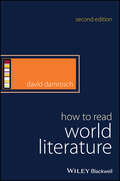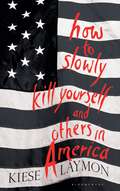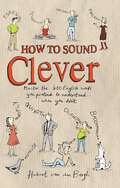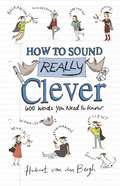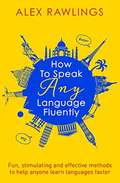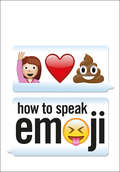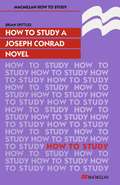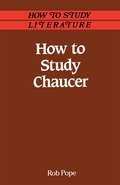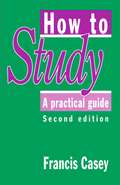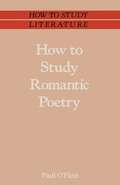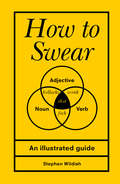- Table View
- List View
How to Read the Chinese Novel
by David L. RolstonFiction criticism has a long and influential history in pre-modern China, where critics would read and reread certain novels with a concentration and fervor far exceeding that which most Western critics give to individual works. This volume, a source book for the study of traditional Chinese fiction criticism from the late sixteenth to the early twentieth centuries, presents translations of writings taken from the commentary editions of six of the most important novels of pre-modern China. These translations consist mainly of tu-fa, or "how-to-read" essays, which demonstrate sensitivity and depth of analysis both in the treatment of general problems concerning the reading of any work of fiction and in more focused discussions of particular compositional details in individual novels.The translations were produced by pioneers in the study of this form of fiction criticism in the West: Shuen-fu Lin, Andrew H. Plaks, David T. Roy, John C. Y. Wang, and Anthony C. Yu. Four introductory essays by Andrew H. Plaks and the editor address the historical background for this type of criticism, its early development, its formal features, recurrent terminology, and major interpretive strategies. A goal of this volume is to aid in the rediscovery of this traditional Chinese poetics of fiction and help eliminate some of the distortions encountered in the past by the imposition of Western theories of fiction on Chinese novels.Originally published in 1990.The Princeton Legacy Library uses the latest print-on-demand technology to again make available previously out-of-print books from the distinguished backlist of Princeton University Press. These editions preserve the original texts of these important books while presenting them in durable paperback and hardcover editions. The goal of the Princeton Legacy Library is to vastly increase access to the rich scholarly heritage found in the thousands of books published by Princeton University Press since its founding in 1905.
How to Read World Literature (How to Study Literature #9)
by David DamroschHow to Read World Literature addresses the unique challenges faced by a reader confronting foreign literature. Accessible and enlightening, Damrosch offers readers the tools to navigate works as varied as Homer, Sophocles, Kalidasa, Du Fu, Dante, Murasaki, Moliere, Kafka, Soyinka, and Walcott. Offers a unique set of "modes of entry” for readers encountering foreign literature Provides readers with the tools to think creatively and systematically about key issues such as reading across time and cultures, reading translated works, and emerging global perspectives Covers a wide variety of genres, from lyric and epic poetry to drama and prose fiction and discusses how these forms have been used in different eras and cultures
How to Read World Literature (How to Study Literature #7)
by David DamroschHow to Read World Literature addresses the unique challenges faced by a reader confronting foreign literature. Accessible and enlightening, Damrosch offers readers the tools to navigate works as varied as Homer, Sophocles, Kalidasa, Du Fu, Dante, Murasaki, Moliere, Kafka, Soyinka, and Walcott. Offers a unique set of "modes of entry” for readers encountering foreign literature Provides readers with the tools to think creatively and systematically about key issues such as reading across time and cultures, reading translated works, and emerging global perspectives Covers a wide variety of genres, from lyric and epic poetry to drama and prose fiction and discusses how these forms have been used in different eras and cultures
How to Read World Literature (How to Study Literature #7)
by David DamroschThe new edition of this highly popular guide, How to Read World Literature, addresses the unique challenges and joys faced when approaching the literature of other cultures and eras. Fully revised to address important developments in World Literature, and generously expanded with new material, this second edition covers a wide variety of genres – from lyric and epic poetry to drama and prose fiction – and discusses how each form has been used in different eras and cultures. An ideal introduction for those new to the study of World Literature, as well as beginners to ancient and foreign literature, this book offers a variety of "modes of entry" to reading these texts. The author, a leading authority in the field, draws on years of teaching experience to provide readers with ways of thinking creatively and systematically about key issues, such as reading across time and cultures, reading works in translation, emerging global perspectives, postcolonialism, orality and literacy, and more. Accessible and enlightening, offers readers the tools to navigate works as varied as Homer, Sophocles, Kalidasa, Du Fu, Dante, Murasaki, Moliere, Kafka, Wole Soyinka, and Derek Walcott Fully revised and expanded to reflect the changing face of the study of World Literature, especially in the English-speaking world Now includes more major authors featured in the undergraduate World Literature syllabus covered within a fuller critical context Features an entirely new chapter on the relationship between World Literature and postcolonial literature How to Read World Literature, Second Edition is an excellent text for undergraduate and postgraduate courses in World Literature. It is also a fascinating and informative read for all readers with an interest in foreign and ancient literature and the history of civilization.
How to Read World Literature (How to Study Literature)
by David DamroschThe new edition of this highly popular guide, How to Read World Literature, addresses the unique challenges and joys faced when approaching the literature of other cultures and eras. Fully revised to address important developments in World Literature, and generously expanded with new material, this second edition covers a wide variety of genres – from lyric and epic poetry to drama and prose fiction – and discusses how each form has been used in different eras and cultures. An ideal introduction for those new to the study of World Literature, as well as beginners to ancient and foreign literature, this book offers a variety of "modes of entry" to reading these texts. The author, a leading authority in the field, draws on years of teaching experience to provide readers with ways of thinking creatively and systematically about key issues, such as reading across time and cultures, reading works in translation, emerging global perspectives, postcolonialism, orality and literacy, and more. Accessible and enlightening, offers readers the tools to navigate works as varied as Homer, Sophocles, Kalidasa, Du Fu, Dante, Murasaki, Moliere, Kafka, Wole Soyinka, and Derek Walcott Fully revised and expanded to reflect the changing face of the study of World Literature, especially in the English-speaking world Now includes more major authors featured in the undergraduate World Literature syllabus covered within a fuller critical context Features an entirely new chapter on the relationship between World Literature and postcolonial literature How to Read World Literature, Second Edition is an excellent text for undergraduate and postgraduate courses in World Literature. It is also a fascinating and informative read for all readers with an interest in foreign and ancient literature and the history of civilization.
How to Slowly Kill Yourself and Others in America
by Kiese Laymon'I was stunned into stillness' Roxane Gay, author of Bad Feminist'I've had guns pulled on me by four people under Central Mississippi skies – once by a white undercover cop, once by a young brother trying to rob me for the left-overs of a weak work-study check, once by my mother and twice by myself. Not sure how or if I've helped many folks say yes to life, but I've definitely aided in a few folks dying slowly in America, all without the aid of a gun'Kiese Laymon grew up in Jackson, Mississippi. That was where he started to write and where he began to seek to create an honest account of living in the US, a country striving to declare itself multi-cultural, post-racial and mostly innocent. This is that account.Drawing on his own personal experiences, these essays are Laymon's attempt to deal with many issues occupying America today, from race, identity and writing to music, celebrity and violence. Through letters between his own disparate family members, pleas to performers whose voices will never be heard again, recollections of his own failure to become a world-famous emcee, analysis of the growing culture of fear in the media and detailed accounts of his clashes with an education system that has both advanced and failed the generation he grew up in, Laymon gets closer not only to the truth behind himself, but to the promises behind the promised land.Searing and passionate, this timely collection of essays introduces a vibrant new voice in US literature and offers a unique insight into the forces that are tearing America apart today.
How to Sound Clever: Master the 600 English words you pretend to understand...when you don't
by Hubert van den BerghHow to Sound Clever explains the etymology of 600 key words you really ought to know, but haven't had the time to look up in the dictionary. Each entry features an etymological description as well as useful example phrases so that readers can quickly see the correct context for each word. Anecdotes and witty illustrations appear throughout to make a book that is entertaining and will help the reader to boost their vocabulary. An ideal gift and a useful book for everyone have to hand when they come across a word you should know, but don't.Colin Dexter has described How to Sound Clever thus: 'This admirable book is a wholly welcome antidote to the semi-demi-literacy of the 21st century. Go out and buy it!'
How to Sound Really Clever: 600 Words You Need to Know
by Hubert van den Bergh Sandra HowgateHow to Sound Really Clever explains and illustrates over 600 words that can outfox us, such as 'condign', 'Zelig-like' and 'agitprop'. This is the sequel to the successful How to Sound Clever (2010) which taught you 600 words you really ought to know but haven't had the time to look up in the dictionary.Each entry features an etymological description as well as useful example phrases so that readers can quickly see the correct context for each word. Anecdotes and witty illustrations appear throughout to make this an entertaining book that will help readers to boost their vocabulary.
How to Sound Really Clever: 600 Words You Need to Know
by Hubert van den Bergh Sandra HowgateHow to Sound Really Clever explains and illustrates over 600 words that can outfox us, such as 'condign', 'Zelig-like' and 'agitprop'. This is the sequel to the successful How to Sound Clever (2010) which taught you 600 words you really ought to know but haven't had the time to look up in the dictionary.Each entry features an etymological description as well as useful example phrases so that readers can quickly see the correct context for each word. Anecdotes and witty illustrations appear throughout to make this an entertaining book that will help readers to boost their vocabulary.
How to Speak Any Language Fluently: Fun, stimulating and effective methods to help anyone learn languages faster (Tom Thorne Novels #22)
by Alex RawlingsThis book will give you the skills to learn to speak any language with confidence. It uses techniques that can easily be incorporated into your daily life, while making use of whatever resources you have available. Whether you are starting out with your first foreign language or wishing to add to your repetoire, you'll find a wealth of easy-to-follow advice and achievable goals. Discover how to:-Speak with greater confidence and accuracy-Effectively learn vocabulary and grammar -Use time on the internet and social media to learn a language-Read real books, websites and articles in a foreign language-Pass exams that certify your language skills
How to Speak Emoji
by Fred BenensonFor anyone who doesn’t know a smiley from a big red heart, a thumbs-up from a toilet symbol, a poo from two blonde girls dancing - this is the first book that will teach you HOW TO SPEAK EMOJI. With a collection of useful phrases and a handy dictionary to demonstrate what the emojis really mean, you’ll never feel out of your depth again - or make the embarrassing mistake of putting an aubergine symbol next to a peach.Including sections like: everyday greetings, in the workplace, in relationships and asking for help and directions, as well as how to translate song titles and film quotes, this is your complete guide to the bright new world of the emoji.
How to Stop Being Stuck with your Academic Writing (How To Guides)
by Seonaidh McDonaldProviding a wealth of advice surrounding different ways of working, collaborating and thinking about your writing, this illuminating How to guide acts as an essential sourcebook for academics at any career stage. Seonaidh McDonald shares authentic stories, offers countless suggestions and provides key resources to help you progress your academic writing.This indispensable guide equips readers with the strategies they need to start writing, and keep writing. Sections can be navigated sequentially, randomly or by linked ideas, offering a myriad of tools and approaches that can be used to develop key writing skills, such as becoming unstuck, drafting and working with others. They also cover a broad range of contemporary scholastic concerns including a section on improving your writing, a discussion of current institutional barriers to academic writing and an extensive resource list.How to Stop Being Stuck with your Academic Writing acts as an essential resource for scholars struggling with their craft or supporting others with their writing. It will also be of interest to academics of business and other social science disciplines including development studies, economics and management seeking to build more consistency and joy into their writing processes.
How to Stop Living and Start Worrying: Conversations with Carl Cederström
by Simon Critchley Carl CederströmThe question of how to lead a happy and meaningful life has been at the heart of philosophical debate since time immemorial. Today, however, these questions seem to be addressed not by philosophers but self-help gurus, who frantically champion the individual's quest for self-expression and self-realization; the desire to become authentic. Against these new age sophistries, How to Stop Living and Start Worrying tackles the question of 'how to live' by forcing us to explore our troubling relationship with death. For Critchley, philosophy begins with the question of finitude and with his understanding of a key classical theme - that to philosophize is to learn how to die. Learning how to accept both our own and others' mortality as a part of life also raises the question of how to love. Critchley argues that the act of love requires us to give up something of ourselves, to lose control so as to be open to the demands of love. We will never be equal to this demand and so we are brought face to face with our own limitations - one form of which is what Critchley calls our 'originary inauthenticity'. By scrutinizing the very nature of humour, Critchley explores what we need to laugh at ourselves and presents the need to confront the inescapable ridiculousness of life. Reflecting on the work of over 20 years, this book provides a unique, witty and erudite introduction to the thought of Simon Critchley. It includes a revealing biographical conversation with Critchley and a fascinating debate with the critically acclaimed novelist Tom McCarthy about the nature of authenticity. Taken together the conversations give an intimate portrait of one of the most lucid, provocative and engaging philosophers writing today.
How to Stop Living and Start Worrying: Conversations with Carl Cederström
by Simon Critchley Carl CederströmThe question of how to lead a happy and meaningful life has been at the heart of philosophical debate since time immemorial. Today, however, these questions seem to be addressed not by philosophers but self-help gurus, who frantically champion the individual's quest for self-expression and self-realization; the desire to become authentic. Against these new age sophistries, How to Stop Living and Start Worrying tackles the question of 'how to live' by forcing us to explore our troubling relationship with death. For Critchley, philosophy begins with the question of finitude and with his understanding of a key classical theme - that to philosophize is to learn how to die. Learning how to accept both our own and others' mortality as a part of life also raises the question of how to love. Critchley argues that the act of love requires us to give up something of ourselves, to lose control so as to be open to the demands of love. We will never be equal to this demand and so we are brought face to face with our own limitations - one form of which is what Critchley calls our 'originary inauthenticity'. By scrutinizing the very nature of humour, Critchley explores what we need to laugh at ourselves and presents the need to confront the inescapable ridiculousness of life. Reflecting on the work of over 20 years, this book provides a unique, witty and erudite introduction to the thought of Simon Critchley. It includes a revealing biographical conversation with Critchley and a fascinating debate with the critically acclaimed novelist Tom McCarthy about the nature of authenticity. Taken together the conversations give an intimate portrait of one of the most lucid, provocative and engaging philosophers writing today.
How to Study a D.H. Lawrence Novel (Study Guides: Literature)
by Nigel MessengerD H Lawrence is a very popular author with young readers, sixth-formers and undergraduates, who respond in general terms but find it difficult to approach Lawrence critically. This book takes students through the steps necessary to fully understand a D H Lawrence novel. Looking at character, plot, language and symbolism, the author shows how complex passages and themes can be decoded and used to spur intelligent, well-written essays.
How to Study a Joseph Conrad Novel (Study Guides: Literature)
by Brian SpittlesThis clear and practical guide shows the reader how to organise a critical response to Joseph Conrad's novels and short stories. It provides systematic guidance on how to analyse Conrad's major works, showing students how to discuss the themes, characters, settings, plots, and tone of his fiction. In addition, it deals with the historical context of Conrad's writings and provides advice on how to discuss such matters as his complex use of narrators and narrative time, his views on politics, and his use of satire and irony. Particular works analysed include Youth, Heart of Darkness, Nostromo, The Secret Agent, Victory and The Shadow-Line. The final chapter offers a step-by-step guide to how to write an essay or examination answer on a Conrad novel. If you are a student looking for help in understanding and writing about Conrad this is the one book you need to read.
How to Study Linguistics: A Guide to Understanding Language (PDF)
by Geoffrey FinchIf you are new to linguistics as a subject and beginning a course at undergraduate or sixth-form level, How to Study Linguistics is the ideal introduction and companion to your studies. #65533; Covers all the core areas of linguistic study, with chapters discussing strategies for studying phonology, syntax and semantics #65533; Explores other branches of linguistics such as sociolinguistics, stylistics, and psycholinguistics #65533; Includes a chapter on writing linguistics essays and a detailed glossary to aid learning and revision #65533; Second edition includes new material designed to help the more advanced reader How to Study Linguistics is both a guide to current ideas about linguistics and a refreshingly practical text book. It will not only develop your skills as a language student, but will also make an often complex and daunting subject easy to understand, and a pleasure to study.
How to Study: A Practical Guide
by Francis CaseyHow to Study teaches the essentially simple techniques of how to organise and approach your work load. The second edition of this invaluable book offers detailed guidance on how to plan your time, use books, make notes, write essays - and prepare for those inevitable examinations. Also featured is a wealth of commonsense advice on using libraries, writing projects and exploiting the benefits of information technology - from computer models to word processors.
How to Study Romantic Poetry (Study Guides: Literature)
by Paul O'FlinnHow do you approach a Romantic poem, and what do the Romantic poets discuss in their works? In this clear, practical guide, Paul O'Flinn shows you how to think and write about Romantic poetry with confidence. He provides a guide to reading four major Romantic poets: Blake, Wordsworth, Coleridge and Keats. A final chapter shows you how to use the book's analytical techniques to write solid essays.
How to Swear: An Illustrated Guide
by Stephen WildishGrasping how to swear is a crucial skill to any English-speaker, but it can be a tricky business. Owing to the rich and complex history of swearing, a single word can have a host of different meanings – from expressing surprise, excitement, anger, celebration, disgust or simply that you’re fucked off. If you don’t get it right, you could really be in the shit.How to Swear, by graphic artist and swearing-connoisseur Stephen Wildish, uses all manner of charts and flow diagrams to teach you all you need to know, including: the building blocks of an effective insult; the adverbial uses of various types of animal excrement (horseshit, apeshit etc); and the different parts of speech a swear word can fulfil: ‘Fucking fuck, the fucking fucker’s fucked’. This charming (and rude) book will take you right to the heart of the wondrous world of swearing, with a lot of laughs on the way.
How to Talk Like a Local: From Cockney to Geordie, a national companion
by Susie DentIf you were a Londoner visiting Cornwall would you know how to recognise a grammersow?If you were from the West Country and took a trip up to Scotland, would you be bewildered if someone described you as crabbit?And what if you left your native Belfast for Liverpool, would you understand if someone called you a woollyback?How to Talk Like a Local is an entertaining guide that gathers together and explains hundreds of words that you would never find in an ordinary dictionary. From dardledumdue, which means day-dreamer in East Anglia, through forkin robbins, the Yorkshire term for earwigs, to clemt, a Lancashire word that means hungry, it covers the enormously rich variety of regional words that pepper the English language. Not only does it pick out unique and unusal local words, it also draws together the dozens of terms from all over the country that mean the same thing, such as knee-knabbed, crab-ankled and hurked-up for knock-kneed, and obzocky, butters and maftin for ugly. In addition, it digs down to uncover the origins of these words, tracing their routes in to the language. Many terms meaning left-handed, for example, are related to the Kerr family of Ferniehirst Castle in Scotland, who preferred left-handed warriors. And many seemingly new coinages have been around for centuries, such as chav, which derives from a Romany word meaning child, or scouse, which probably comes from lapskaus, a Norwegian word for a sailors' stew. If you're intrigued by these colourful words and phrases, if you're interested in how English is really spoken, or if you want to discover how our language has evolved over the years, How to Talk Like a Local will prove irresistible - and enlightening - reading.
How to Talk Teen: From Asshat to Zup, the Totes Awesome Dictionary of Teenage Slang
by Mark LeighTHE PERFECT GIFT FOR MOTHER'S DAY, 26 MARCH!What's ILL in one place can be WACK in another, or the same word can actually have TOTES different meanings. It's CRAY CRAY! From KEWL girls hitting on HENCH boys to wannabe gangstas hangin' with their DOGGS in the ENDZ, teen slang can leave NOOBS CONFUZZLED. If you want to appear DOPE or just want to know WTF is going on, How to Talk Teen is the ultimate guide!Bugly : Short for butt ugly; exceeded on the ugly ranking by dugly and fugly. Pfun: More than mere fun. This is pure fun. Rando: A random person who appears at parties but who no one seems to know, let alone invited.Hiberdating: Disappearing from view because you're spending almost all your time with your new boyfriend/girlfriend.Nodel: Someone who thinks they look like a model . . . but nobody else does.Rentsy: Acting like parents, i.e. acting responsibly or demonstrating a nauseating taste in music. Mis-wave: To wave back at someone you think is waving at you, but who was actually waving to someone else.Ugly radius: The distance from you that someone stops looking attractive.Hot mess: Someone attractive who looks cool and in control, but who's an emotional train wreck. Lipsin: Kissing energetically - but less aggressively than a full-on snog.Selfie claw: Your contorted hand as you simultaneously hold your phone and take the photo.Air Five: High-five greeting to someone from across a room.Endz: The street where you live or the immediate neighbourhood. Pit stick: Underarm antiperspirant/deodorant.Top bantz: Particularly insightful or mocking banter. Hashtag Douchebag: A moron who uses hashtags excessively in anything they type in an attempt to be witty


